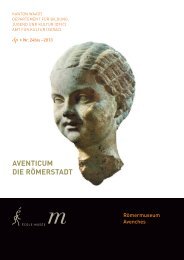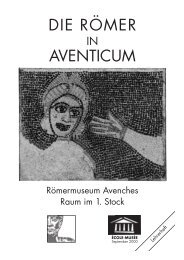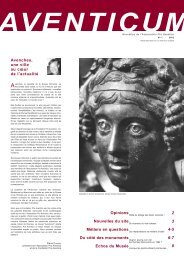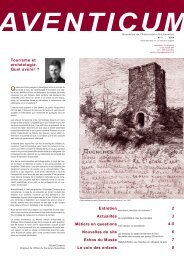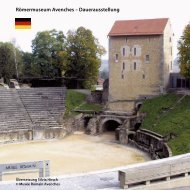Avenches – Roman Museum – Permanent Exhibition
Avenches – Roman Museum – Permanent Exhibition
Avenches – Roman Museum – Permanent Exhibition
You also want an ePaper? Increase the reach of your titles
YUMPU automatically turns print PDFs into web optimized ePapers that Google loves.
First Floor Rome and Aventicum<br />
The Emperor, the Imperial Family and the Province<br />
12. Antoninianus, Tetricus I (AD 271 <strong>–</strong> 274).<br />
13. Antoninianus, Aurelian (AD 270 <strong>–</strong> 275).<br />
14. Follis, Diocletianus (AD 284 <strong>–</strong> 305).<br />
15. A loaf of bread costs 1 as.<br />
16-18. An oil lamp costs 2 as ( = 1 dupondius = 1/2 sestertius).<br />
19-20. A goblet costs 1 as.<br />
21. As, reverse depicting the personification of Money holding scales.<br />
22. Coin balance with predetermined weight, Julio-Claudian period.<br />
23. Denarius, silver, Augustus (27 BC <strong>–</strong> AD 14).<br />
24. Official denarius, silver (with a Z-shaped mint mark), Tiberius.<br />
25. Denarius, counterfeit, silver-plated copper, Nero (1).<br />
26. Denarius, counterfeit, silver-plated copper, Domitian.<br />
27. Denarius, cast counterfeit, alloy with low silver content.<br />
28. Sesterce, counterfeit, copper (?)-plated iron, Marcus Aurelius.<br />
29. Dupondius or as, counterfeit, copper (?)-plated iron, Marcus Aurelius for Faustina the<br />
Younger.<br />
30-36. Isolated finds from archaeological excavations.<br />
37-42. Contents of a purse: 6 sesterces.<br />
43. Hoard (?) of denarii.<br />
44. Moneybox, 2nd century AD (2).<br />
Rome and Aventicum<br />
(Display cases 16-18)<br />
The Emperor, the Imperial Family and the Province<br />
Rome exercised its power and influence over its territory in various ways. A rigorous<br />
organisation ensured the administration of the provinces. In general, the official<br />
language (Latin in the West, Greek in the East), legislation, monetary and fiscal<br />
systems as well as standard measures and weights were imposed upon the<br />
provinces. Loyalty and obedience towards Rome and the emperor were expected.<br />
The Latin term urbs, originally just the Latin word for “town”, was synonymous<br />
for Rome, the capital of the Empire. It is often represented by the she-wolf feeding<br />
the twins Romulus and Remus, the emblem illustrating the myth of the foundation<br />
of the capital.<br />
The power of the emperor and his family became very apparent in the imperial<br />
cult (display case 17, no. 6), introduced by Augustus. The living emperor was<br />
considered to be divine. At Aventicum the imperial cult was probably celebrated in<br />
the Cigognier sanctuary where the gold bust of Marcus Aurelius was found. Images<br />
of the emperor and of members of his family were present in the form of statues<br />
1<br />
2<br />
33<br />
First Floor<br />
15<br />
16<br />
17<br />
18



